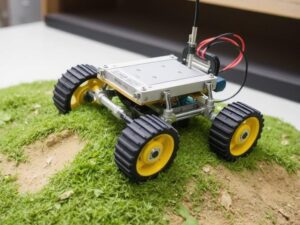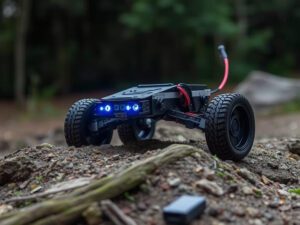Robot mobility is a groundbreaking technology that could change an astronomical number of industries, ranging from shipping to farming and exploration to search and rescue. Imagine packages delivered to your door by robots, scanning fields for crops of gargantuan sizes, or trawling through hazardous terrain. However, to allow robots to move and function in our world, they must overcome one small problem: terrain. Robot mobility terrain issues are a basic research and development problem. The basic mobility challenges in robots, owing to diverse terrains, and the advanced solutions being created to cross them form the topic of this essay. Robot mobility terrain issues are a basic research and development problem.
Robots will have to move across various kinds of terrain with various kinds of obstacles. They are:
- Uneven Ground: Potholes, rocks, and trash impact robot balance and traction.
- Slopes and Hills: Slopes and hills require robots to exert additional force and balance.
- Obstacles: Obstacles like trees and walls require advanced navigation and obstacle avoidance algorithms.
- Environmental Conditions: Rain, snow, and sand impact traction and visibility.
- Mixed Terrain: Robots typically must cross a variety of terrains for a mission.


Uneven Surfaces
Uneven ground is probably the greatest mobility problem for robots. Standard-wheeled robots can only handle slightly more than their wheel diameter. Researchers are creating many diverse solutions:
- Advanced Suspension Systems: This gives independent movement of each wheel on the ground and stability. Think of a car’s suspension system, but ten times more technologically sophisticated.
- Flexible Wheels: Flexible material wheels allow for bending around an object, with the added benefit of more traction.
- Legged Robots: Animal-inspired legged robots allow for walking on extremely rough terrain by slowly lowering each leg. A great example of such a robot is Boston Dynamics’ Spot.
- Tracked Robots: Tank-like tracked robots allow for weight distribution to be simpler, making them have more traction and be capable of driving over an obstacle.
Climbing Slopes and Hills
Slopes and hills are a form of robotic mobility terrain. Robotic mobility needs to have sufficient power and traction to move robots uphill and sufficient tipping or sliding resistance on hills.
- High-Torque Motors: High-torque motors provide robots with the capability of climbing hills.
- Special Tires: Special rubber compound tires, or deep tread tires, provide extra traction on slippery hills.
- Centre of Gravity Control: Moving the centre of gravity of the robot allows for more stability in climb and descent.
- Braking Systems: Advanced braking systems allow robots not to roll downwards on a slope or slide down and up slopes uncontrollably.
Obstacle Avoidance and Navigation
Obstacle avoidance is the key to safe and successful robot driving. Robots need to be able to sense the world and drive in such a manner that they can turn without running into things.
- Sensors: Lidar, radar, and cameras inform robots about the world. Lidar shoots lasers to build a 3D model of the world.
- Mapping: Robots map the world so that they know where the obstacles are and how to navigate around them. Simultaneous Localisation and Mapping (SLAM) is a technique where robots localise in the map while simultaneously building the map.
- Path Planning Algorithms: These enable robots to plan the safest and best route to the destination while considering obstacles and terrain.
- Artificial Intelligence (AI): AI is increasingly being used in obstacle avoidance to equip the robots with experience-based learning and improvement from the past and response to unexpected situations.
Environmental Adjustments
Rain, snow, and sand are only a few of the environmental conditions that have a significant impact on the mobility of the robots.
- Waterproofing: The component parts of the robot have to be waterproofed whenever the robots traverse water-covered ground.
- Traction Control: Traction control systems and tires specifically designed for it cause robots to gain traction on slippery roads.
- Weather Sensors: Environmental change can be detected by deploying weather sensors utilised by robots appropriately.
- Temperature Management: Extremely low or high temperatures influence battery performance as well as electronics functionality.
The Issue of Unstable Ground
Robots prefer to traverse varied terrain on the trip. Robots must automatically and seamlessly adjust to varying conditions.
- Terrain Sensing: Robots can sense different types of terrain and change locomotion modes appropriately.
- Self-Tuning Control Programs: Self-tuning control programs allow the robots to automatically modify speed, gait, and other parameters based on the terrain.
- Multi-Modal Locomotion: Robots in certain applications possess two or more than two modes of locomotion, i.e., wheels and legs, to move on different kinds of terrain.
Examples of Robotic Mobility Solutions
- Mars Rovers: Mars rovers need to navigate the rough Martian terrain composed of sand dunes, rocks, and craters.
- Agricultural Robots: Agricultural robots perform planting, weeding, and harvesting operations by moving through primarily uneven or muddy terrain.
- Delivery Robots: They deliver packages to residences and businesses, moving on sidewalks, roads, and even stairs.
- Search and Rescue Robots: They are being used in search and rescue operations, moving on aggressive and unstructured terrain.


The Future of Robotic Mobility
Robotic mobility is a field of the future, and technology and solutions are being created daily. As technology and artificial intelligence continue to grow, robots will be an even more dominant player in almost every aspect of life. Research and development of technologies such as sensor technology, material sciences, and artificial intelligence will create even more sophisticated mobility systems for robots that will be able to move even on difficult terrain. Robots will be doing complex operations on all types of terrain, from the bottom of the ocean to space. Advances in science and engineering are posing robot mobility terrain challenges.
Robot mobility terrain challenges are no joke. However, with research and technological advancement, great strides are being achieved. The more sophisticated the mobility of robots in intricate worlds, the more the possibility of application, business, and our world. The future for robotic mobility is bright, with a world in which robots move and interact with the world around them in a very normal way. Robotic mobility terrain needs are one facet of enabling this ability.









































Leave a Review